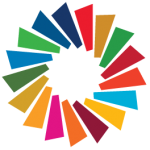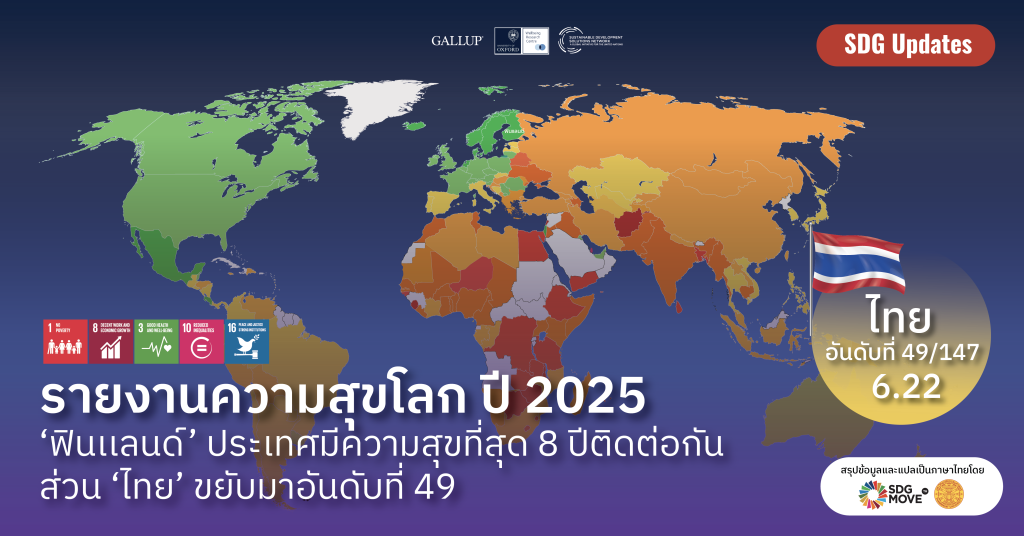Dr. Nuttavikhom Phanthuwongpakdee
Lecturer, Puey Ungphakorn School of Development Studies,
Thammasat University
The Sustainable Development Solutions Network (SDSN), in collaboration with the University of Oxford and its partners, has released the World Happiness Report 2025, drawing on data from the Gallup World Poll and other sources. The report ranks 147 countries based on six key factors influencing wellbeing, including social support, income, life expectancy, freedom, generosity, and perceptions of corruption.
Globally, Finland retains its position as the world’s happiest country for the eighth consecutive year. In Asia, Thailand has shown the most significant improvement, climbing nine spots to 49th place with an average score of 6.22 out of 10, the highest leap of any country in the region this year. Within the Association of Southeast Asian Nations (ASEAN), Thailand now ranks among the top three happiest countries, following Singapore and Vietnam.
Often perceived as a society grounded in close family ties, communal support, and cultural warmth, Thailand is commonly associated with happiness. Recent data reinforces this reputation, particularly in areas such as social support, while also highlighting ongoing challenges in health, personal freedom, and governance.
This edition of SDG Updates invites readers to explore the global and regional state of happiness, with a focus on Thailand’s performance, the key drivers of well-being, and the country’s evolving position within the ASEAN community.
00 – Key Points to Know Before Reading the Report
The World Happiness Report 2025 ranks countries based on six key factors used to assess the overall happiness of populations. These factors are derived from the Gallup World Poll and supplemented by other data sources.
The Six Key Factors in the 2025 Report:
- Social Support – Having someone to rely on during times of need.
- GDP per Capita – Reflecting the average income per person as an indicator of quality of life.
- Healthy Life Expectancy – The average number of years people can expect to live in good health.
- Freedom to Make Life Choices – The ability to make important life decisions independently.
- Generosity – Frequency and scale of acts of giving and helping others.
- Perceptions of Corruption – Public trust in government and business sectors.
How the Happiness Score Is Calculated:
- The Happiness Score is based on respondents’ average self-assessed life evaluation, measured on a scale from 0 to 10 using the Cantril Ladder (Cantril’s Self-Anchoring Scale).
- Each country’s score represents a three-year average, ensuring greater stability and accuracy in capturing long-term trends.
- Data is drawn from approximately 1,000 respondents per country per year.
01 – Global Overview: Europe Dominates the Top 5, While the U.S. Hits a Record Low in Happiness Rankings
Note: Areas in white represent countries that were not included in the ranking.
The World Happiness Report 2025, based on surveys conducted in 147 countries, finds that Finland remains the happiest country in the world for the eighth consecutive year, with an average score of 7.74 out of 10. All of the top five countries are located in Europe: Denmark ranks second (7.52), followed by Iceland (7.51), Sweden (7.34), and the Netherlands (7.31).
At the bottom of the list, Afghanistan ranks 147th with the lowest happiness score globally (1.36). Of particular concern is the women’s average happiness score, which stands at just 1.16, reflecting profound gender inequality and deteriorating quality of life for women in the country. The other lowest-ranking countries include Sierra Leone (3.00), Lebanon (3.19), Malawi (3.26), and Zimbabwe (3.40).
The report highlights Costa Rica (6th) and Mexico (10th) as the most improved countries in 2025, first appearing in the global top ten. This marks a promising shift toward improved well-being in countries prioritising quality of life and strong social connections. Looking at longer-term trends since the first report in 2012, Serbia, Bulgaria, and Georgia show the most significant gains in happiness, with notable increases in their average scores over the past decade.
However, the report also notes troubling declines in happiness in several countries. The United States, for example, has dropped to 24th place, its lowest ranking in the report’s history, compared to 11th in 2012. Meanwhile, Europe has seen rising within-country inequality in happiness over the past 15 years, even as between-country differences have remained relatively stable.
Happiness levels remain low in Sub-Saharan Africa due to economic instability, political conflict, and climate uncertainty. In many Middle Eastern countries, challenges such as social instability and low trust in governance persist, especially in nations experiencing ongoing conflict and political transitions.
Globally, the report underscores a decline in social trust and persistent concerns over “deaths of despair”. While data from 59 countries shows a decrease in such deaths by an average of five per 100,000 people between 2000 and 2019, the trend remains alarming in some areas. In Japan and South Korea, for instance, suicide rates among working-age adults remain high. The United States also sees rising levels of social stress, contributing to broader dissatisfaction with society and politics.
Other Key Global Findings:
- Over 19% of young people worldwide report having no one to turn to for social support, which has risen by 39% since 2006.
- People globally underestimate the kindness of others. For instance, the actual rate of returned lost wallets is twice as high as most people expect.
- Shared meals play a significant role in happiness and vary widely across cultures. Their impact on well-being is comparable to that of income and unemployment.
- Family size correlates with happiness. In Mexico and parts of Europe, families with 4–5 members report the highest happiness levels. However, in Europe, many still live alone, raising concerns about social isolation.
- Social relationships are essential for adolescent well-being, acting as a buffer against the toxic effects of stress.
02 – Overview of the Happiness Index in ASEAN and Thailand
Top 9 ASEAN Countries by Happiness Ranking
The overall happiness rankings for ASEAN member states remain relatively consistent with last year. Within the region, Thailand ranks in the top three among Southeast Asian countries. Singapore leads the region at 34th place globally, although its position dropped four spots compared to the previous year. It is followed by Vietnam (46th), Thailand (49th), the Philippines (57th), Malaysia (64th), Indonesia (83rd), Laos (93rd), Cambodia (124th), and Myanmar (126th). Brunei Darussalam was not included in this year’s rankings.
Only three countries in the region improved their positions compared to the 2024 report: Vietnam, Thailand, and Laos. In contrast, six countries saw their rankings decline: Singapore, the Philippines, Malaysia, Indonesia, Myanmar, and Cambodia.
The Association of Southeast Asian Nations (ASEAN) is a regional organisation that promotes cooperation in economic, political, and social affairs among Southeast Asian countries. It comprises ten member states: Brunei, Cambodia, Indonesia, Laos, Malaysia, Myanmar, the Philippines, Singapore, Thailand, and Vietnam.
In a broader East Asian context, Taiwan ranks 27th globally, making it the highest-ranking country in East Asia. It is followed by Hong Kong (42nd), Japan (55th), which continues to score lower than many of its Asian counterparts, largely due to persistent issues of social isolation, followed by South Korea (58th) and China (68th).
Factors Behind Thailand’s Leap in the Happiness Rankings
According to the World Happiness Report 2025, Thailand’s performance across the six key evaluation criteria shows varying levels of progress. The scores for each dimension are as follows:
- Perceptions of Corruption: 0.04 – the lowest among all indicators
- Freedom to Make Life Choices: 0.93
- Social Support: 1.55 (an increase from the previous year)
- Healthy Life Expectancy: 0.63
- Generosity: 0.22
- GDP per Capita: 1.43
Compared to the 2024 report, Thailand experienced a decline in three areas:
- Healthy Life Expectancy dropped by 0.833 points
- Generosity decreased by 0.063 points
- GDP per Capita fell by 0.054 points
Despite these declines, Thailand ranks 8th globally regarding social support, reflecting the strength of Thai social networks, particularly support within families and communities. In contrast, Thailand’s GDP per Capita ranks 81st globally, though recent economic improvements may have enhanced public perceptions of financial security.
However, the country continues to face challenges in other areas. Notably, freedom to make life choices ranks 121st, highlighting ongoing concerns about limited personal freedoms. Perceptions of corruption remain low, with Thailand ranking 83rd, indicating persistent issues in governance and transparency.
These trends illustrate how various factors, including economic security, social cohesion, and institutional trust, influence national happiness. The findings also offer deeper insights into the multidimensional nature of well-being across different countries.
Access the World Happiness Report 2025 here: www.worldhappiness.report/2025/
This article is relevant to;
#SDG1 No poverty
#SDG3 Good Health and Well-being
– (3.4) by 2030 reduce by one-third pre-mature mortality from non-communicable diseases (NCDs) through prevention and treatment, and promote mental health and wellbeing
#SDG8 Decent work and economic growth
– (8.1) sustain per capita economic growth in accordance with national circumstances, and in particular at least 7% per annum GDP growth in the least-developed countries
#SDG10 Reduced Inequality
– (10.2) by 2030 empower and promote the social, economic and political inclusion of all irrespective of age, sex, disability, race, ethnicity, origin, religion or economic or other status
#SDG16 Peace, Justice and Strong Institutions
– (16.5) substantially reduce corruption and bribery in all its forms
– (16.7) ensure responsive, inclusive, participatory and representative decision-making at all levels

